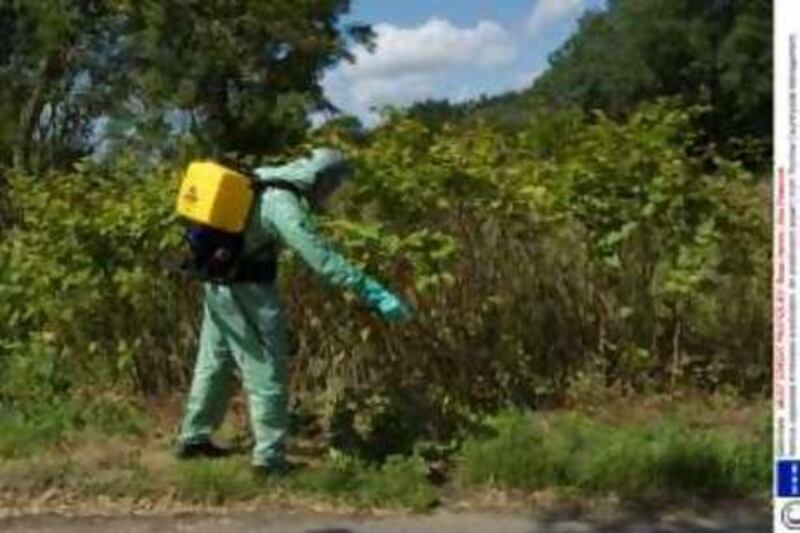Imagine how proud the British merchant navy captain CJ Leyland must have felt when, in 1888, he created a tree by propagating two strains of North American cypresses. A keen gardener when he wasn't sailing the oceans, Capt Leyland was immensely gratified when the new breed was named after him - the leylandii. Unbeknown to him, his crowning achievement was actually something of a Frankenstein moment and Capt Leyland and his arboreal creation have been cursed in the UK ever since. Much loved by privacy seekers for its lush, rapid growth, the tree is now hated by many British home owners, with its oppressive, dull green leaves and ability to shoot up quickly to 30 metres or more, blocking out the sun and wrecking the view. In fact, people feel so strongly about Leyland's creation that thousands of civil court cases have been brought by those living under its shadow and neighbourly disputes have led frequently to un-neighbourly violence and, on at least one occasion, even murder. In 2003, the British government stepped in, adding a "High Hedges" section to the Parliamentary Anti-Social Behaviour Act, empowering local authorities to investigate complaints and order owners to trim their trees. To be fair to Capt Leyland, it must have seemed a good idea at the time. So too the introduction of Japanese knotweed in 1850 by a Dutch botanist who reckoned its tall, bamboo-like branches and small creamy flowers would make a striking addition to Victorian herbaceous borders. Who could have guessed that, from one single clone, over the years the imported knotweed would grow to become a creeping 21st century menace, with roots strong enough to break through three inches of Tarmac and wreak havoc with the foundations of buildings? Then there are the plants, insects and mammals that arrive by accident - on the puff of a wind, the pull of a current, by aeroplane or ship - only to munch, crunch and smother the indigenous ecosystem by clogging up the waterways, killing off rival species and stunting the growth of plants. As if global economic meltdown were not enough, the United Kingdom and Europe are at the mercy of an alien invasion which is estimated to be costing at least £2 billion (Dh12bn) a year to control. "The numbers have increased hugely in recent years thanks to the movement in trade and people," says Dr David Roy, of the Natural Environment Research Council. He recently co-ordinated a project called Daisie - Delivering Alien Invasive Species Inventories for Europe - and estimated the number of these alien species could be as high as 11,000. "We found that approximately 15 per cent of the aliens within Europe are known to have some impact on the environment or economy - and this problem goes across all taxonomic groups; mammals, plants and insects." And this is about more than mere zoological and botanical xenophobia. "They can be a danger to our health," he says. "Take two examples; there are more mosquitoes in the UK than before and the Ambrosia plant, which is prevalent in Spain and Germany, has very high allergenic qualities and causes asthma. "And they are a threat to our natural order. Aliens can break down the barriers between species and if that is taken to the extreme it would lead to a global reduction in species which would have an effect on evolution itself." In a kind of payback for the days of imperial ambition, Great Britain, once the great coloniser of the world, is in turn being colonised by unwelcome guests. Surrounded by water, the island nation has some natural defence against species incursion - yet has repeatedly lowered its ecological drawbridge. In the early 20th century a small, tusked deer known as the muntjac, or barking deer, was imported to a Bedfordshire stately home from South-east China to add an exotic touch to the sprawling grounds. By the 1950s they were escaping into the surrounding countryside in large numbers and, as Britain's motorway network spread, so did they, travelling along the green embankments to far-flung corners of the country, where they still do untold damage to the countryside, eating crops and damaging trees. If only they had developed an appetite for leylandii. The signal crayfish was introduced from North America in the late 1970s for aquaculture, but soon spread a disease in UK waterways which has killed off the native white-clawed crayfish. These aquatic vandals also burrow into the banks of canals and rivers, threatening them with collapse. Another water-bound terror is the Chinese mitten crab - so called because of its furry claws - which took hold in the 1980s after large numbers were released into the Thames in the ballast water of ships. Now there are untold millions of them eating whatever they can get their greedy claws into - which includes weeds, fish eggs, snails and molluscs. As their territories expand, biologists are watching with nervous anticipation to see what will happen when the alien crabs and crayfish finally meet, as they are predicted to do shortly in rivers in the south and the north of the country. Even Britain's colonies have suffered. It must have seemed perfectly reasonable when, in 1859, immigrant Thomas Austin introduced 24 wild rabbits to hunt on his estate in Victoria, Australia. Oh dear. Naturally, they bred like rabbits and the continent is still struggling to cope with the carnage wrought by those busy bunnies, thought to be responsible for the extinction of one eighth of all mammals, the stripping of bark from countless trees and, thanks to the animal's relentless consumption of plants leaving topsoil exposed, widespread serious erosion. Humans are not always to blame for the unknowing introduction of unsuitable species to fragile habitats. Frequently these ecological wrecking squads arrive unannounced and unsuspected; take the toxic Oak Processionary Moth (Thaumetopoea processionea), a species native to central and southern Europe. Its caterpillars feed on oak leaves and their silky hairs contain a toxin which can cause severe irritation to human skin. The harlequin ladybird was introduced to Europe from Asia to control the spread of aphids on crops. One theory is that it may have hitched a lift to the UK on a cross-Channel ferry in 2004, but however it got there, this pretty little insect has shown itself to be a ravening cannibal which likes nothing better than dining on its native British rivals. Despite mankind's poor record in playing off one species against another, experts are poised to gamble again, this time in the war against knotweed. It is estimated that it would cost several billion pounds to remove the plant from the UK but now the Centre for Agricultural Bioscience International thinks it has identified two natural predators from Japan - an aphid and a fungus - that could control its growth. If their use is approved by the UK's Department for Environment, Food and Rural Affairs (Defra) it will be the first time that bio-control - the use of a natural enemy to control a pest - has been used in Britain. But, says Ruth Waters of Natural England, a public body funded by Defra, "There is always a risk with bio-control because you cannot guarantee what the knock-on effect might be. It has to be a balanced judgement as to whether the risks from the bio-control are worse than the impact of the species." As the leylandiis and knotweeds attest, one problem is that there is often quite a time lag before the terrible truth about non-native species is discovered. "Some of them might seem absolutely fine and benign then suddenly increase massively," warns Dr Waters. "You don't know which ones are going to be a danger until it is too late." Some have more obvious destructive potential than others. "We need to keep an eye out for the Indian House Crow, which has reached the continent," she says. "It is a voracious scavenger of insects, eggs, chicks, grain and fruit. "Then there are the sacred ibis which were released from botanical gardens in France and allowed to roam free. They look lovely but they are spreading havoc around the north French coast of Britanny, eating the eggs of other birds, and they will do the same here if we are not careful." The most dangerous threats, however, are not always the most obvious, says Dr Waters. "Knotweed gets more publicity because it has more economic impact. If you are building a housing estate where there is knotweed it costs a lot to make sure it doesn't come through the kitchen floor of your new houses. "But there is a fungal disease which is infecting our amphibious population to such an extent that we could lose all our toads and great swathes of amphibians. It won't lose money like a building site but it is very significant as far as our wildlife is concerned." One problem facing the UK is that there is no legal framework to stem the tide of these malignant outsiders. South Africa, for example, has a special agency which co-ordinates identification and prevention, but the UK and Europe rely on only public awareness and voluntary behaviour. "Prevention has not been good in the past," says Dr Waters. "The best we can do is develop science, increase surveillance and speed up our rapid response to try to control things." Sometimes, of course, nature provides its own solutions to the problems it creates. The unloved leylandii appears finally to be getting its comeuppance - not thanks to the courts or axe-wielding neighbours, but at the hands of another invasive species. A plague of the conifer aphid, Cinara cupressivora, has arrived from the Mediterranean, sucking the sap and munching its way through the evergreen, forcing many homeowners to uproot their languishing leylandii and replace them with other, less contentious greenery. Of course, it remains to be seen whether this helpful little fellow might yet reveal itself to be the next ruthless invader. * The National
Invasion of the eco-snatchers
Decisions to introduce fascinating alien plants, animals and insects into unsuspecting ecosystems do not always end happily.

Editor's picks
More from the national





